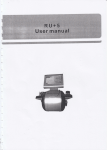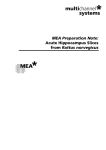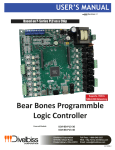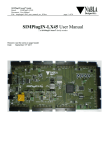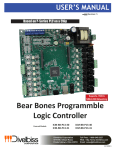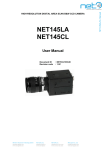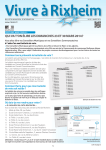Download DIGIFLOW OEM Ultrasonic Flow Measuring Board - User Manual -
Transcript
DIGIFLOW the OEM Ultrasonic Flow Measuring Board - User Manual - All rights reserved, Copyright © em- tec 2003 DIGIFLOW – User Manual 1. Contents 1. 2. 3. 4. 5. Contents ..................................................................................................................... 2 Safety Instructions ...................................................................................................... 3 Symbols and Abbreviations ....................................................................................... 5 Theory of Measurement ............................................................................................. 6 Specifications of the DIGIFLOW Board ................................................................... 7 5.1 Dimensions and Pin Assignments....................................................................... 7 5.2 Description of the Interfaces............................................................................... 8 5.3 Technical Data of the DIGIFLOW Board........................................................... 9 6. Specifications of the Clamp-on Transducer............................................................. 10 6.1 Technical Data and Range of Transducer......................................................... 10 7. Installation of the DIGIFLOW Board and Transducer ............................................ 11 7.1 Environmental Requirements............................................................................ 11 7.2 Installation of the DIGIFLOW Board ............................................................... 12 7.3 Mounting of the Transducer.............................................................................. 14 7.4 Troubleshooting ................................................................................................ 15 8. Order and Service Procedures.................................................................................. 17 Note: All information in this document is subject to change without notice. Names and data used in the examples are fictitious. No part of this document may be reproduced or transmitted in any form or by any means, electronic or mechanical, for any purpose, without the express written permission of em-tec GmbH. Version FHM 1.0 Page 2/ 17 DIGIFLOW – User Manual 2. Safety Instructions Read this User Manual carefully before you start the installation! Terms and Definitions DIGIFLOW Transducer Main Unit / User System Customer / User OEM ultrasonic transit-time flow measuring board which must be used in combination with a Transducer. Device to transmit and receive ult rasound signals which will be analysed by the DIGIFLOW board. Host system into which the DIGIFLOW was integrated by the customer. Person or company who uses the DIGIFLOW as OEM part in combination with their own system. Indication The DIGIFLOW is indicated to measure the liquid volume flow in flexible plastic tubes. It was especially designed for the integration into different user systems. For this reason the intended use will be depend ent on the user application of the main unit. The environmental parameters and technical specifications, which must be strictly adhered to, are described on following pages. Contraindication The DIGIFLOW is only constructed and sold for the above mentioned purposes. Medical applications: In case that the DIGIFLOW shall be integrated in a medical system the user has to observe the following instructions. The DIGIFLOW was designed to monitor the function of the equipment which generate the flow (e. g. oxygenator/pump ), but NOT to monitor vital patient parameters like a patient monitor. This unit shall NOT be intended for use as the sole basis for diagnosis without confirmation by another established medical procedure. Should the unit be used to control the liquid volume flow, the user has to analyse the risk of the application and if necessary, do flow board independent actions to minimize this risk. Version FHM 1.0 Page 3/ 17 DIGIFLOW – User Manual Liabilities and Responsibilities The user is responsible to use, check and maintain the DIGIFLOW according to this user manual. Furthermore he is liable and responsible for updating approvals and reviewing the technical file of the main unit in which the DIGIFLOW was included. em-tec is not liable or responsible for any consequences arising out of use of the DIGIFLOW which is not compare with the instructions or specifications of this manual. General Safety Instructions The DGIFLOW was developed and manufactured according to the newest technologies and production procedures (state-of-the-art). Before installation the user has to read this manual carefully to prevent hazards and injury for the user or damage to the user system in case of improper use. The service for the DIGIFLOW may be carried out by em-tec only. For this reason the malfunctioning systems must be shipped back to em-tec. em-tec recommends that the system should be calibrated every 2 years. Electrical Safety The integration of the DIGIFLOW in the customer unit or the combination with other units must be realised according to IEC 60601 and further relevant national standards. Use of an electrical cauterising knife If you allow a cauterising knife to touch the measuring system or the extracorporeal tubes the flow display could be inaccurate. Cleaning and Disinfection After use of the DIGIFLOW system the Transducer should be cleaned, i.e. open the enclosure, remove the tube and eliminate splattered blood or gel from the housing with a lint- free cloth. Use only agents for cleaning and disinfection which have been tested and approved by your local Health Authority. Work in a well- ventilated room. Pay attention that no agents ingress into the housing. Do not dip the whole Transducer into fluids! Solvents Chemical solvents like alcohol, aether, acetone etc. must not be used in or on any parts of the DIGIFLOW System. Do not spill anaesthetics on the unit or on any accessories. Chemicals like Foran (Isofluoran) could be very damaging for the system. Version FHM 1.0 Page 4/ 17 DIGIFLOW – User Manual 3. Symbols and Abbreviations Warning, must be observed strictly Important instruction Alternating current (AC) Type BF, Safety class according VDE 0750 Part1 IPX1 IPX1, Protection against or from dripping water Connection for potential equalisation Version FHM 1.0 Page 5/ 17 DIGIFLOW – User Manual 4. Theory of Measurement B Transmitter/ Receiver Flow a Receiver/ Transmitter Tube A The DIGIFLOW uses the ultrasonic transit-time method to measure volumetric flow through the tube. Liquid is flowing through the Transducer and carries with it the sound wave produced by the piezoceramic (A and B). The measurement is made twice; once upstream and once downstream. The transit time is determined in both cases and the difference is proportional to the volumetric flow. Other factors such as used tube size, ultrasonic frequency, fluid type, temperature and transducer characteristic s must considered for determination of the actual volumetric flow. Version FHM 1.0 Page 6/ 17 DIGIFLOW – User Manual 5. Specifications of the DIGIFLOW Board 5.1 Dimensions and Pin Assignments Version FHM 1.0 Page 7/ 17 DIGIFLOW – User Manual 5.2 Description of the Interfaces Board J101-Pin 1 J101-Pin 2 J101-Pin 3 J101-Pin 4 J101-Pin 5 J101-Pin 6 J101-Pin 7 J101-Pin 8 J101-Pin 9 J101-Pin 10 J101-Pin 11 J101-Pin 12 J101-Pin 13 J101-Pin 14 J101-Pin 15 J101-Pin 16 J101-Pin 17 Signal + 15V, ± 5% + 15V, ± 5% - 15V, ± 5% - 15V, ± 5% + 5V, ± 2,5% + 5V, ± 2,5% + 5V, ± 2,5% GND GND GND GND TxD * RxD * SPI-IN SPI-OUT SPI-SCLK /RESET J101-Pin 18 R_TRIGGER ** J101-Pin 19 J101-Pin 20 CAN_HI CAN_LO Description Operating voltage, supply current of 130 mA is required Operating voltage, supply current of 80 mA is required Operating voltage, supply current of 800 mA is required Ground connection Transmitter serial data output from serial port Receiver serial data input SPI-interface input SPI-interface output SPI-interface clock input Input signal to restart the DIGIFLOW board (low active, TTL level) Input signal to define the measurement period of the flow measurement (positive edge sensitive) CAN 2.0B interface high line CAN 2.0B interface low line Option Description * * ** For switching to the RS232 level close JMP19 Pin 2-3 and JMP20 Pin 2-3 For switching to the TTL level close JMP19 Pin 1-2 and JMP20 Pin 1-2 To enable the R_TRIGGER input close JMP21 Pin 2-3 Settings of the serial communication port Baud rate: Data bits: Stop bits: Parity: Version FHM 1.0 38400 Baud 8 1 none Page 8/ 17 DIGIFLOW – User Manual 5.3 Technical Data of the DIGIFLOW Board Principle of measurement: Board size: Total height: Connection to the Transducer: Connection to the main system: Power requirements (DC): Interfaces: Max. scan rate: ADC sampling rate: Transmitter frequency range: Zero flow offset adjustment: Flow range: Flow resolution: Flow accuracy: Flow offset drift: Version FHM 1.0 ultrasonic transit-time method 114,2 x 95,2mm about 40mm (incl. space bolts and supply cables) enclosed cable set AMP MICROMATCH Male, 20 pole + 5V, ± 2,5%, 800mA + 15V, ± 5%, 130mA 6 Watts - 15V, ± 5%, 80mA - RS232 (CAN and SPI on request) - R-Trigger (TTL Input) 1000 Hz 36 MHz 15 kHz to 18 MHz, different patterns possible, resolution 8 bit yes 0 to 9.99 LPM 0.01 LPM 0.0 to 1.0 LPM: ± 0.1 LPM + offset drift 1.1 to 9.99 LPM: ±7 % of actual value + offset drift max. 0.05 LPM Page 9/ 17 DIGIFLOW – User Manual 6. Specifications of the Clamp-on Transducer 6.1 Technical Data and Range of Transducer Transducer Type Tube Size Flow Range COT-012-332A COT-038-332A COT-014-116A 1/2” x 3/32” 3/8” x 3/32” 1/4” x 1/16” 20 lpm 15 lpm 8 lpm Dimension WxHxD 60 x 28 x 41 54 x 25 x 38 52 x 20 x 35 Protection class (IP code): Material of the housing: Type of probes: Cable: Connector: IPX1 - protected against dripping water aluminium Z-Type (X-Type on request) 5 x 2 wires, 0,05mm², shielded twisted pair, 2 m 15 pole High Density D-SUB Tube material: Medium inside the tube: PVC, silicon (other materials on request) water, blood (other mediums on request) Version FHM 1.0 Page 10/17 DIGIFLOW – User Manual 7. Installation of the DIGIFLOW Board and Transducer The DIGIFLOW system consists of electrostatic sensitive devices. Handle only at static safe work stations according to IEC 61340-5-2! 7.1 Environmental Requirements Temperature limits: Operating: Transportation: Storage: 17°C to 45°C –18°C to 55°C –18°C to 45°C Operating: Transportation: Storage: 30 % to 75 % non-condensing 10 % to 96 % non-condensing 10 % to 96 % non-condensing Operating: Transportation: Storage: 87 to 106 kPa 70 to 106 kPa 70 to 106 kPa Relative humidity: Atmospheric pressure: Version FHM 1.0 Page 11/17 DIGIFLOW – User Manual 7.2 Installation of the DIGIFLOW Board Install the DIGIFLOW board according to IEC 60601 and further relevant national standards! The board must be fixed inside the main unit by 4 screws (recommended 2,5 mm in diameter) in combination with plastic space bolts (recommended 10 mm). Ensure that the board is fitted without any tension. All environmental conditions must meet the prescribed specifications (see chapter 7.1). The connection between the DIGIFLOW board and the Transducer was realised by a cable set which was enclosed the shipment. The included HD SUB-D jack should be mounted on the housing of the main unit (use the enclosed screws). Should it be necessary to shorten the cable use the pin assignment which was listed on page 7. After the mechanical installation connect the prescribed supply voltages and signals to the J101 on board AMP MICROMATCH male. Attention! A short circuit resulting from an incorrect assignment of the wires will damage the DIGIFLOW system. If the DIGIFLOW board was successful installed a start up message will be transmitted via the serial data communication port to the main unit. Status information such as the following will be edited by using a TVI925 terminal emulation. DIGIFlow FlowMeter -------------------Software Revision: V1.00 Build from: Sep 22 2003 Serial No: DigiFlow 01 13:51:31 SELFTEST IRAM internal check: External WDT check: Flash ROM on chip check: CAN1_RAM on chip check: EEPROM check: PASSED PASSED PASSED PASSED PASSED XPER/XRAM on chip check: PASSED CAN2_RAM on chip check: PASSED Offset Check[mV]: 0 (0 mV) +5V Check[mV]: 596 +-15V Check[mV]: 1023 (4092 mV) Temperature check: 426 PASSED Self-Test (4768 mV) PASSED Press 'esc'-Key for Service Menue! Version FHM 1.0 Page 12/17 DIGIFLOW – User Manual After showing the results of the initial self test the DIGIFLOW board transmits a data string such as the following via the serial communication port to the main unit: Parameter String 1 2 3 4 5 6 7 8 9 00 08 +1592 +1590 +113 +0 +1254 +1590 +454 The data string consists of the following parameters separated by blanks: Parameter 1: error byte (hex) of the DIGIFLOW board (see troubleshooting, too) Parameter 2: status information (hex) of the flow measurement board DIGIFLOW Bit 7: Sensor 1 connected Bit 6: currently unused Bit 5: Signal amplitude below 39% Bit 4: currently unused Bit 3: PVC tube detected Bit 2: Silicone tube detected Bit 1: flow values not ok or amplitude below 49% Bit 0: temperature of flow board to high (> 65 °C) Parameter 3: mean flow value integrated over 1 second in ml/min Parameter 4: actual flow value in ml/min Parameter 5: signal amplitude of the acoustic receiving signal in % (100% is set to signal amplitude of 2.66 V) Parameter 6: additional information for calibration purposes (only for service) Parameter 7: measured transition time in picoseconds Parameter 8: integrated flow value from R-Trigger to R-Trigger signal (if enabled by jumper setting) or integrated flow value over 10 seconds Parameter 9: board temperature in 0.1 °C The data string will be finished by a carriage return (0x0d) and a line feed (0x0a) character. Temperature Control Function The board temperature will be checked by the µController continuously (parameter 9 of data string). A temperature above 65°C will be set in the status byte. The temperature alarm flag in the status byte will be cleared if the board temperature decreases below 60°C. Should the board temperature further increase above 75°C a temperature error will be set in the error byte (see chapter “Troubleshooting”). The temperature control function should be implemented for control purpose only. Independent thereof has to be enough cooling inside the housing in which the DIGIFLOW will be built in (< 45°C). Version FHM 1.0 Page 13/17 DIGIFLOW – User Manual 7.3 Mounting of the Transducer Select the Transducer according to the used tube size and connect it to the installed DIGIFLOW board via the 15 pin High Density D-SUB jack. If the unit is running properly the included EEPROM will be readable and the DIGIFLOW board will receive the stored Transducer data automatically. If you should have problems, please see also the chapter „Troubleshooting“. Before you start the measuring, you have to clamp-on the Transducer to the tube according to the following instructions. Press the tube in the housing and close the Transducer. The arrow which you can see on the enclosure should be in flow direction, so you will get positive flow values. Pay attention that the tube is not damaged or deformed on the position where you want to clamp on the Transducer. The tube should also be straight (unbent) for reaching laminar flows and exact measuring values. In case that you do not attain enough ultrasound coupling the tube must be greased by coupling gel before you clamp-on the transducer. Use the original coupling gel (Order No: 10385) only! We do not guarantee sufficient ultrasound coupling for a longer measurement time if you should use other gels. Version FHM 1.0 Page 14/17 DIGIFLOW – User Manual 7.4 Troubleshooting During the start up and normal operation of the DIGIFLOW several self tests are running. The result of these tests will be transmitted via the serial communication port to the main unit. In case that a test fails an error code will be stored in the transmitted error byte. Additionally, an error indication will be displayed by the OK-LED which is located on the top side of the board (see page 7). If the unit is running properly the LED is on. In case of error detection the LED will be switched off. Example of a failed self test: DIGIFlow FlowMeter -------------------Software Revision: V1.00 Build from: Sep 22 2003 Serial No: DigiFlow 01 13:51:31 SELFTEST IRAM internal check: PASSED External WDT check: PASSED Flash ROM on chip check: PASSED CAN1_RAM on chip check: PASSED EEPROM check: FAILED XPER/XRAM on chip check: PASSED CAN2_RAM on chip check: PASSED Offset Check[mV]: 0 (0 mV) +5V Check[mV]: 596 +-15V Check[mV]: 1023 (4092 mV) Temperature check: 426 PASSED Self-Test (4768 mV) FAILED A data string with error indication is following: 19 2A +1087 +1090 +113 +0 +1089 +0 +0 Parameter1 (error byte) = 0x19 à EEPROM test error Further error indications are described on the following page. Version FHM 1.0 Page 15/17 DIGIFLOW – User Manual Description of the Error Byte: 0x00 0x01 0x02 0x03 0x04 0x05 0x06 0x07 0x08 0x0A 0x0B 0x0C 0x0D 0x0E 0x0F 0x10 0x11 0x12 0x13 0x14 0x15 0x16 0x17 0x18 0x19 0x1A 0x1B 0x1C 0x21 0x22 Version FHM 1.0 no error FLASH error at test STP0 FLASH error at test STP1 FLASH error at test STP2 FLASH error at test STP3 FLASH error at test STP4 FLASH error at test STP5 RAM error at test STP0 RAM error at test STP1 RAM error at test STP2 RAM error at test STP3 RAM error at test STP4 RAM error at test STP5 Watch Dog Timer defect error in task handling error during JMP-Check internal ADC error (status STP0) internal ADC error (status STP1) internal ADC error (status STP2) internal ADC error (status STP3) internal ADC error (status STP4) internal ADC error (status STP5) internal ADC offset error +5V test error EEPROM test error Board temperature error (> 75°C) +15V check error -15V test error EEPROM CRC error Calibration factor inconsistent Page 16/17 DIGIFLOW – User Manual 8. Order and Service Procedures DIGIFLOW DIGIFLOW Board including Cable Set and User Manual Order No: 11088 Accessories Transducer (COT-012-332A), tube size:1/2" x 3/32" Transducer (COT-038-332A), tube size:3/8" x 3/32" Transducer (COT-014-116A), tube size:1/4" x 1/16" Ultrasound Coupling Gel Order No: 11056 Order No: 11048 Order No: 11032 Order No: 10385 Please contact our sales department if you want order the DIGIFLOW system or accessories. Do not hesitate to get in touch with our salesmen if you should have any questions. em-tec GmbH Sales Department Lerchenberg 20 D 86923 Finning Germany Tel.: ++49 8806 9236-0 Fax: ++49 8806 9236-50 Mail [email protected] In case that a unit seems to be malfunctioning, please inform our service department before you send it to em-tec. Our support engineers will help you solve the problem. Please use the original package if you send back the malfunctioning system to em-tec. Enclose the shipment a detailed description of the failure. Name and phone number or email address of the person who is able to give further information would be helpful. em-tec GmbH Service Department Lerchenberg 20 D 86923 Finning Germany Tel.: ++49 8806 9236-0 Fax: ++49 8806 9236-50 Mail [email protected] You can get general information about new products and updates on our web page: www.em-tec.de Version FHM 1.0 Page 17/17

















